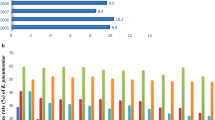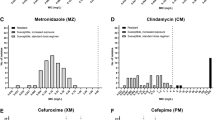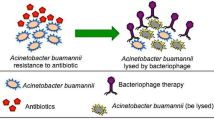Abstract
Background
Melioidosis an infectious disease, caused by a Gram negative bacterium called Burkholderia pseudomallei, is endemic in Bangladesh. This organism is sensitive to limited number of antimicrobial agents and need prolonged treatment. There is no comprehensive data on the antimicrobial susceptibility profile of B. pseudomallei isolated in Bangladesh over last several years. The present study aimed to determine the antimicrobial susceptibility pattern of B. pseudomallei isolated in a tertiary care hospital of Dhaka city from 2009 to 2015.
Methods
All B. pseudomallei isolated from melioidosis patients over a period of 7 years (2009–2015) in the Department of Microbiology of a 725-bed tertiary care referral hospital in Dhaka city, Bangladesh were included in the study. B. pseudomallei was identified by Gram stain, culture, specific biochemical tests, serology and PCR using specific primers constructed from 16s rRNA region of B. pseudomallei. Antimicrobial susceptibility to specific agents was determined by disk diffusion and minimum inhibitory concentration methods.
Results
A total of 20 isolates of B. pseudomallei which were isolated from patients coming from different geographic locations of Bangladesh were included in the study. All the isolates were uniformly sensitive (100%) to ceftazidime, imipenem, piperacillin–tazobactam, amoxicillin–clavulanic acid and tetracycline by both disk diffusion and MIC methods. Two strains were resistant to trimethoprim–sulfamethoxazole by disk diffusion method but were sensitive by MIC method. The MIC50 and MIC90 values of the above antimicrobial agents were almost similar. All the isolates were resistant to amikacin by both MIC and disk diffusion methods.
Conclusion
The results of the study suggest that B. pseudomallei prevalent in Bangladesh were still susceptible to all recommended antimicrobial agents used for the treatment of melioidosis. However, regular monitoring is needed to detect any emergence of resistance and shifting of MIC50 and MIC90 values.
Similar content being viewed by others
Background
Burkholderia pseudomallei is a Gram negative saprophytic bacterium that causes melioidosis. It is an endemic disease of public health and clinical importance in many countries of the world including Bangladesh [1,2,3]. Several cases have been reported from Bangladesh since 1988 [3, 4]. Recently, we have found that the organism is present in the soil samples of Bangladesh and about 22.6–30.8% of people residing in melioidosis endemic districts of Bangladesh were sero-positive for anti- B. pseudomallei IgG antibody [5].
Melioidosis may be manifested as localized or disseminated infection involving multiple organs of the body. The disease is usually fatal if left untreated. Treatment of melioidosis requires prolonged courses of antibiotics. The current treatment regime has an intensive and maintenance phase. In the intensive phase, ceftazidime is usually the drug of choice. However, carbapenem (imipenem/meropenem) is recommended in severe infection and treatment failure cases. This is followed by the maintenance phase which consists of oral administration of TMP–SMX or TMP–SMX and doxycycline or amoxicillin–clavulanic acid [6,7,8,9]. But recently, there are reports of resistant B. pseudomallei to ceftazidime, TMP–SMX, amoxicillin–clavulanic acid from different melioidosis endemic countries of the world including neighboring India [9,10,11,12,13,14,15].
Currently, no comprehensive information is available on the antimicrobial susceptibility pattern of B. pseudomallei isolated from patients in Bangladesh. Therefore, the present study was undertaken to determine the antibiotic susceptibility pattern of B. pseudomallei isolated from patients during the period of 2009–2015 in our hospital by disc diffusion and minimum inhibitory concentration (MIC) methods.
Methods
Study organisms
All B. pseudomallei isolated from melioidosis patients over a period of 7 years (January 2009 to December 2015) in the Department of Microbiology of a 725-bed tertiary care referral hospital in Dhaka city, Bangladesh were included in the study. B. pseudomallei was identified by typical colony morphology, Gram staining (bipolar staining), motility, biochemical tests, arabinose assimilation and resistance to colistin and aminoglycoside [16]. Monoclonal antibody based latex agglutination test (Melioidosis Research Center, Khon Kaen, Thailand) was performed for the final identification and confirmation of B. pseudomallei. Serologically confirmed B. pseudomallei isolates were further confirmed by PCR using specific primers constructed from 16s rRNA region of B. pseudomallei [17].
Determination of MIC
Minimum inhibitory concentrations of all antibiotics against B. pseudomallei were determined by agar dilution method [18]. Briefly, Muller–Hinton agar plates containing different dilutions of specific antimicrobial agent were spot inoculated with 104 organisms. Each spot was 5–8 mm in diameter. All reading was taken between 18 and 24 h of incubation at 37 °C in aerobic condition. The MIC represented the lowest concentration of antimicrobial agents at which complete inhibition of growth of the organism occurred. The MIC (μg/ml) interpretation for susceptible (S), intermediate (I), and resistant (R) for amoxicillin–clavulanic acid, ceftazidime, imipenem, tetracycline and TMP–SMX was carried out following the CLSI approved guideline M45-A2 [19]. As reported earlier, the MIC breakpoint of P. aeruginosa for piperacillin–tazobactam, amikacin and gentamicin as mentioned in CLSI guideline was used to interpret the MIC of B. pseudomallei [14, 20]. The detail MIC interpretive values used in the study are shown in Table 1.
Disc diffusion method
The isolates were tested for susceptibility to ceftazidime (30 µg), imipenem (10 µg) piperacillin–tazobactam (30 µg), amoxicillin–clavulanic acid (30 µg), tetracycline, TMP–SMX (1.25/23.75 µg), gentamicin (10 µg) and amikacin (30 µg) by disc diffusion technique [21]. Briefly, a 0.5 McFarland suspension of each bacterial isolate was made in normal saline and inoculated onto Mueller–Hinton agar (Oxoid Ltd, UK) to prepare a uniform lawn. The disks were applied at a specific distance from each other and the zone of inhibition around the antibiotic disc was measured after 18 h of incubation of plates at 37 °C. Since interpretative standards for zone sizes of tested antibiotics are not available for B. pseudomallei, we used the Clinical and Laboratory Standards Institute [20] threshold zone sizes for members of the family Enterobacteriaceae and Pseudomonas aeruginosa as reported earlier [14]. The zone of inhibition was interpreted as sensitive, intermediate and resistant according to CLSI guideline. The zone sizes used for interpretation are shown in Table 1.
Each isolate was tested in duplicate by disk diffusion and MIC methods. All disks and antibiotics were obtained from Oxoid Ltd., Basingstoke, Hampshire, UK and Sigma, USA. Potency of the disks and antimicrobial agents were standardized using the reference strain E. coli ATCC 25922.
Results
A total of 20 B. pseudomallei which were isolated from patients coming from different geographic locations of Bangladesh were included in the study. All the isolates were uniformly sensitive (100%) to ceftazidime, imipenem, piperacillin–tazobactam, amoxicillin–clavulanic acid and tetracycline by both disk diffusion and MIC methods. Two strains were resistant to TMP–SMX by disk diffusion method but were sensitive by MIC method (Table 2). The MIC value of those two isolates were 1/19 and 2/38 µg/ml while by disk diffusion test their zone diameter was below the recommended cut off value of 16 mm. The MIC50 and MIC90 values of the above antimicrobial agents were almost similar (Table 2). The MIC50 and MIC90 of amoxicillin/clavulanic acid were towards higher side compared to other agents tested. All the isolates were resistant to amikacin by both MIC and disk diffusion methods. All 20 isolates were resistant to gentamicin by disk diffusion test.
Discussion
Mortality in patients with B. pseudomallei infection is high and early diagnosis and specific antimicrobial therapy is necessary to reduce the fatal outcome [21,22,23]. The antibiotic of choice for melioidosis is ceftazidime, a third generation cephalosporin. Imipenem is considered as alternatives to ceftazidime. Since relapse rates are high, initial parenteral treatment followed by maintenance therapy with oral TMP–SMX (8–12 & 40–62 mg/kg/day) or doxycycline (4 mg/kg/day) or amoxicillin–clavulanic acid (20/5 mg/kg 8 h) for 12–20 weeks are recommended [6,7,8]. However, B. pseudomallei resistant to ceftazidime, tetracycline/doxycycline and TMP–SMX, has been recently reported from Malaysia, Thailand and Australia. About 0.6% B. pseudomallei in Malaysia was found to be resistant to imipenem, ceftazidime, doxycycline and amoxicillin–clavulanic acid while the rate was 10% for TMP–SMX [9]. The rate was around 0.6% in Thailand [14]. About 4% B. pseudomallei in Australia was reported as resistant to imipenem, ceftazidime, doxycycline and TMP–SMX [12].
In Bangladesh there was no comprehensive data available on the antibiotic susceptibility pattern of B. pseudomallei. Bangladesh is a melioidosis endemic country and several cases have been documented since 1988 and, recently we have reported its presence in the soil from a district where several cases of melioidosis were diagnosed [3,4,5]. Organisms included in the present study were isolated from patients mainly coming from different areas of north and north-eastern part of Bangladesh during the period of 2009–2015. The result showed that all the isolates were uniformly sensitive to imipenem, ceftazidime, piperacillin–tazobactam, tetracycline, amoxicillin–clavulanic acid and TMP–SMX. The absence of resistance to these antibiotics in our isolates might be due to the fact that only a few numbers of organisms were tested. Therefore, in our settings, these antimicrobial agents can empirically be used to treat suspected melioidosis patients prior to the availability of culture and sensitivity results.
Comparing the results of the disk diffusion test with that of MIC it appeared that the CLSI recommended breakpoint of zone diameter for P. aeruginosa, and Enterobacteriaceae could be used to interpret the zone of inhibition by B. pseudomallei in disk diffusion test where facilities for MIC test is lacking or till the zone diameter of B. pseudomallei for these agents are standardized. MIC and disk diffusion tests showed concordant results for all antimicrobials except for TMP–SMX. Only, two isolates were resistant to TMP–SMX by disk diffusion method (zone diameter 15 mm) whereas both were found sensitive to TMP–SMX by MIC method (≤1/19 and 2/38 µg/ml). Since MIC method is considered as the gold standard for determining the susceptibility of B. pseudomallei to TMP–SMX [19], therefore, all our 20 isolates were actually sensitive to TMP–SMX. The interpretation of susceptibility of B. Pseudomallei to TMP–SMX by disk diffusion test is sometimes affected by slight hazy growth within the zone of inhibition and blurring of margin. Therefore, the doubtful result of disk diffusion test for TMP–SMX should be confirmed by MIC method.
Burkholderia pseudomallei is intrinsically resistant to aminoglycosides like gentamicin and amikacin [24]. These antibiotics are used as diagnostic agents for identification of B. pseudomallei in culture. Also, most selective media incorporate gentamicin in the medium as a selective agent to isolate B. pseudomallei from soil and other samples. Though B. pseudomallei is said to be resistant to aminoglycosides, there have been reports of aminoglycoside sensitive isolates (0.1%) from Thailand [25, 26], and from Australia [27]. Recently it has been reported that 86% of B. pseudomallei isolates in Sarawak, Malaysian Borneo were sensitive to gentamicin [28]. The strains belonged to sequence type 881 and 997. In view of the above, we have determined the susceptibility of our strains to amikacin, an aminoglycoside. All the 20 isolates were resistant to amikacin by both disk diffusion (zone diameter range 10–15 mm) and MIC method (MIC 64–512 µg/ml). It may be mentioned that all these strains were also resistant to gentamicin where no zone of inhibition was observed by disk diffusion method. Therefore, it is assumed that amikacin and gentamicin may be used safely as a diagnostic disk and in selective media for isolation of the organism from soil and other contaminated samples.
Conclusion
The study, though with limited number of isolates, revealed that the prevalent B. pseudomallei in Bangladesh were susceptible to recommended antimicrobial agents used for both intensive and maintenance phase therapy. Continuous monitoring of antimicrobial susceptibility should be maintained to detect emergence of resistant organism.
Abbreviations
- TMP–SMX:
-
trimethoprim–sulfamethoxazole
- Pip–Tazo:
-
piperacillin–tazobactam
- Amox–Clav:
-
amoxicillin/clavulanic acid
- PCR:
-
polymerase chain reaction
- MIC:
-
minimum inhibitory concentration
- IgG:
-
immunoglobulin G
- CLSI:
-
Clinical and Laboratory Standards Institute
References
Limmathurotsakul D, Dance DAB, Wuthiekanun V, Kaestli M, Mayo M, Warner J, et al. Systematic review and consensus guidelines for environmental sampling of Burkholderia pseudomallei. PLoS Negl Trop Dis. 2013;7(3):e2105. doi:10.1371/journal.pntd.0002105.
Limmathurotsakul D, Peacock SJ. Melioidosis: a clinical overview. Br Med Bull. 2011;99:125–39.
Barai L, Jilani MSA, Haq JA. Melioidosis—case reports and review of cases recorded among Bangladeshi population from 1988–2014. Ibrahim Med College J. 2014;8:25–31.
Struelens MJ, Mondol G, Bennish M, Dance DA. Melioidosis in Bangladesh: a case report. Trans R Soc Trop Med Hyg. 1988;82:777–8.
Jilani MSA, Robayet JAM, Mohiuddin M, Hasan MR, Ahsan CR, Haq JA. Burkholderia pseudomallei: its detection in soil and seroprevalence in Bangladesh. PLoS Negl Trop Dis. 2016;10(1):e0004301. doi:10.1371/journal.pntd.0004301.
Samuel M, Ti TY. Interventions for treating melioidosis. Cochrane Database Syst Rev. 2002. doi:10.1002/14651858.CD001263.
Pitman MC, Luck T, Marshall CS, Anstey NM, Ward L, Currie BJ. Intravenous therapy duration and outcomes in melioidosis: a new treatment paradigm. PLoS Negl Trop Dis. 2015;9(3):e0003586. doi:10.1371/journal.pntd.0003586.
Gilad J, Harary I, Dushnitsky T, Schwartz D, Amsalem Y. Burkholderia mallei and Burkholderia pseudomallei as bioterrorism agents: national aspects of emergency preparedness. Israel Med Assoc J. 2007;9:499–503.
Ahmad N, Hashim R, Noor AM. The in vitro antibiotic susceptibility of Malaysian isolates of Burkholderia pseudomallei. Int J Microb. 2013. doi:10.1155/2013/121845.
Irmawanti-Rahayu S, Noorhamdani AS, Santoso S. Resistance pattern of Burkholderia pseudomallei from clinical isolates at Dr. Saiful Anwar general hospital, Malang-Indonesia. J Clin Microbiol Infect Dis. 2014;1(1):17–20.
Sarovich DS, Price EP, Von Schulze AT, Cook JM, Mayo M, Watson LM, Richardson L, Seymour ML, Tuanyok A, Engelthaler DM, Pearson T, Peacock SJ, Currie BJ, Keim P, Wagner DM. Characterization of ceftazidime resistance mechanisms in clinical isolates of Burkholderia pseudomallei from Australia. PLoS ONE. 2012;7:e30789. doi:10.1371/journal.pone.0030789.
Jenny AWJ, Lum G, Fisher DA, Currie BJ. Antibiotic susceptibility of Burkholderia pseudomallei from tropical northern Australia and implications for therapy of melioidosis. Int J Antimicrob Agents. 2001;17:109–13.
Thibault FM, Hernandez E, Vidal DR, Girardet M, Cavallo JD. Antibiotics susceptibility of 65 isolates of Burkholderia pseudomallei and Burkholderia mallei to 35 antimicrobial agents. J Antimicrob Chemother. 2004;54:1134–8.
Wuthiekanun V, Amornchai P, Saiprom N, Chantratita N, Chierakul W, Koh GCKW, et al. Survey of antimicrobial resistance in clinical Burkholderia pseudomallei isolates over two decades in northeast Thailand. Antimicrob Agents Chemother. 2011;11:5388–91.
Behera B, Prasad Babu TL, Kamalesh A, Reddy G. Ceftazidime resistance in Burkholderia pseudomallei: first report from India. Asian Pac J Trop Med. 2012;5(4):329–30.
Lipuma JJ, Currie BJ, Lum GD, Vandamme PAR. Burkholderia, Stenotrophomonas, Ralstonia, Cupriavidus, Pandrea, Brevundimonus, Comamonas, Delftia, and Acidovorax. In: Murray PR, Baron EJ, Jorgensen JH, Landry ML, Pfaller MA, editors. Manual of clinical microbiology. 9th ed. Washington, DC: ASM Press; 2007. p. 749–69.
Maude R, Maude R, Ghose A, Amin M, Islam M, Ali M, et al. Seroepidemiological surveillance of B. pseudomallei in Bangladesh. Trans R Soc Trop Med Hyg. 2012;106:576–8.
Washington JA II. Susceptibility tests: agar dilution. In: Lennette EH, Balows A, Hausler WJ, Shadomy HJ, editors. Manual of clinical microbiology. 4th ed. Washington, DC: American Society for Microbiology; 1985. p. 967–71.
Clinical and Laboratory Standards Institute. Methods for antimicrobial dilution and disk susceptibility testing of infrequently isolated or fastidious bacteria M45-A2, vol. 30. 2nd ed. Wayne: Clinical and Laboratory Standards Institute; 2010.
Performance Standards for Antimicrobial Susceptibility Testing M100-S25. Twenty-fifth Informational Supplement, vol. 35. 3rd ed. Wayne: Clinical and Laboratory Standards Institute; 2015.
Bauer AW, Kirby WMM, Sherris JC, Truck M. Antibiotic susceptibility testing by a standardized single disk method. Am J Clin Pathol. 1966;36:493–6.
Cheng AC, Currie BJ. Melioidosis: epidemiology, pathophysiology and management. Clin Microbiol Rev. 2005;18(2):383–416.
Haq JA. Melioidosis in Bangladesh. Bangladesh J Pathol. 1998;13(1):1–2.
Moore RA, DeShazer D, Reckseidler S, Weissman A, Woods DE. Efflux-mediated aminoglycoside and macrolide resistance in Burkholderia pseudomallei. Antimicrob Agents Chemother. 1999;43:465–70.
Simpson AJH, White NJ, Wuthiekanun V. Aminoglycoside and macrolide resistance in Burkholderia pseudomallei. Antimicrob Agents Chemother. 1999;43:2332.
Trunck LA, Propst KL, Wuthiekanun V, Tuanyok A, Beckstrom-Sternberg SM, Beckstrom-Sternberg JS, Peacock SJ, Keim P, Dow SW, Schweizer HP. Molecular basis of rare aminoglycoside susceptibility and pathogenesis of Burkholderia pseudomallei clinical isolates from Thailand. PLoS Negl Trop Dis. 2009;3:e519. doi:10.1371/journal.pntd.0000519.
Price EP, Sarovich DS, Mayo M, Tuanyok A, Drees KP, Kaestli M, Beckstrom-Sternberg SM, Babic-Sternberg JS, Kidd TJ, Bell SC, Keim P, Pearson T, Currie BJ. Within-host evolution of Burkholderia pseudomallei over a twelve-year chronic carriage infection. MBio. 2013;4(4):13. doi:10.1128/mBio.00388-13.
Podin Y, Sarovich DS, Price EP, Kaestli M, Mayo M, Hii K, et al. Burkholderia pseudomallei isolates from Sarawak, Malaysian Borneo, are predominantly susceptible to aminoglycosides and macrolides. Antimicrob Agents Chemother. 2014;58(1):162–6.
Authors’ contributions
SD performed the culture, identification and antimicrobial susceptibility tests. SH performed the antimicrobial susceptibility tests, literature search and manuscript writing. MRH was involved in storage and identification of organisms and primary data analysis. JAH was involved in study design, analysis of the data and manuscript writing. All authors read and approved the final manuscript.
Acknowledgements
Not applicable.
Competing interests
The authors declare that they have no competing interests.
Availability of data and materials
All relevant data of this study are within the paper.
Funding
The work was done with the departmental funds.
Publisher’s Note
Springer Nature remains neutral with regard to jurisdictional claims in published maps and institutional affiliations.
Author information
Authors and Affiliations
Corresponding author
Rights and permissions
Open Access This article is distributed under the terms of the Creative Commons Attribution 4.0 International License (http://creativecommons.org/licenses/by/4.0/), which permits unrestricted use, distribution, and reproduction in any medium, provided you give appropriate credit to the original author(s) and the source, provide a link to the Creative Commons license, and indicate if changes were made. The Creative Commons Public Domain Dedication waiver (http://creativecommons.org/publicdomain/zero/1.0/) applies to the data made available in this article, unless otherwise stated.
About this article
Cite this article
Dutta, S., Haq, S., Hasan, M.R. et al. Antimicrobial susceptibility pattern of clinical isolates of Burkholderia pseudomallei in Bangladesh. BMC Res Notes 10, 299 (2017). https://doi.org/10.1186/s13104-017-2626-5
Received:
Accepted:
Published:
DOI: https://doi.org/10.1186/s13104-017-2626-5




